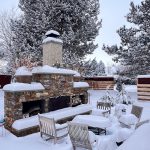
This is the wrap-up of my fall lawn series for lawn geeks, and those not so geeky! I’ll follow up in about a month when those baby grass blades are making a new lawn for you!
 If you’ve read my previous posts, I’m sure you’re getting a sense that cultivating and maintaining a beautiful, lush lawn doesn’t happen by accident, especially in our fringe climate of central Virginia. One item I have failed to mention is the importance of soil testing. That could be another post all by it’s self. It is important to feed the soil what it needs for the type of vegetation you are growing, and only a soil test will reveal those needs, especially pH adjustments. Most garden centers have soil test kits available that are sent to Virginia Tech for analysis and a report is mailed back to you. A private lab (A & L in RVA) may offer soil testing with expedited results via email. http://www.aleastern.com/taking_soil_sample.html Costs vary but are minimal.
If you’ve read my previous posts, I’m sure you’re getting a sense that cultivating and maintaining a beautiful, lush lawn doesn’t happen by accident, especially in our fringe climate of central Virginia. One item I have failed to mention is the importance of soil testing. That could be another post all by it’s self. It is important to feed the soil what it needs for the type of vegetation you are growing, and only a soil test will reveal those needs, especially pH adjustments. Most garden centers have soil test kits available that are sent to Virginia Tech for analysis and a report is mailed back to you. A private lab (A & L in RVA) may offer soil testing with expedited results via email. http://www.aleastern.com/taking_soil_sample.html Costs vary but are minimal.
FERTILIZATION
The typical strategy in central VA for the fall season is to follow the “SON” calendar (September, October, November) for cool season lawn fertilization. Timing depends more importantly on the key ingredient in fertilizers- nitrogen, and whether it is slow (Water Insoluble Nitrogen or “WIN” for short) or quick release. Nitrogen is a quality vs. quantity factor, and is applied by a pounds per 1000 square feet of lawn.
All fertilizers have an numerical analysis or N-P-K rating, Nitrogen, Potassium, Potash. A “starter” fertilizer should be applied at the same time the lawn is seeded and has a rating with a higher percentage of P (Potassium) such as 10-20-15. The higher P promotes germination and root growth The best choices for fertilizer applications that follow in October and November have a different N-P-K ratings for each, such as 25-0-15 (higher Nitrogen promotes blade growth) and 10-0-20 (higher Potash for winterization.)
 Product offerings are plentiful. A knowledgeable sales person at a garden center can also advise. Fertilizer bags will tell you how much area a bag will cover and most people are happy to follow that recommendation. If you use a weed & feed product make sure it doesn’t contain pre-emergent control and follow instructions carefully to insure strong germination. Always check a forecast and wait to apply fertilizers if rain is on the way.
Product offerings are plentiful. A knowledgeable sales person at a garden center can also advise. Fertilizer bags will tell you how much area a bag will cover and most people are happy to follow that recommendation. If you use a weed & feed product make sure it doesn’t contain pre-emergent control and follow instructions carefully to insure strong germination. Always check a forecast and wait to apply fertilizers if rain is on the way.
Now you have prepared, seeded, and fertilized your lawn. From this point, watering is crucial as seed will not germinate without it. I set our irrigation system to run 3-4 minutes each zone, three times a day. The point is to keep the seed moist but not soggy. In a couple of weeks or so depending on weather, etc. you should see a beautiful lawn beginning to emerge! Once the seed is up watering may be reduced to every couple of days, and less as it becomes established. I reseed after 3-4 weeks any areas that did not take well.
If you like to get a little more technical, visit the website of the VIRGINIA COOPERATIVE EXTENSION: http://pubs.ext.vt.edu/430/430-011/430-011.html
Related posts:
Tags: Landscape design, lawn
Leave a Reply Cancel reply

More Story
Yes Virginia, It's Time For Grass Seed!
The grass seed installment in my lawn series! Text is continued from Yes Virginia, It’s Time For Your Lawn! part 3 Mid...Subscribe to the Blog
Site Menu
Recent Posts
- What's a gardener to do... in winter?
Jan 22, 2024 - New Year, New Plans!
Jan 1, 2024 - The Thoughtful Host
Dec 7, 2023
- What's a gardener to do... in winter?

You may link to a post or take quotes if credit, including a link back, is given.
You may not take entire posts or photographs without asking.
Permission may be requested using the contact form .













Share On